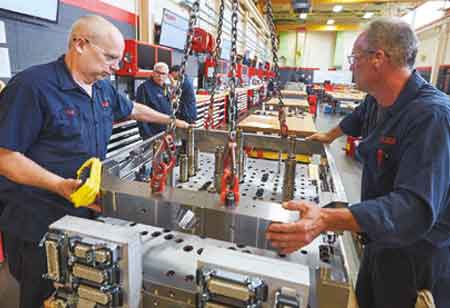THANK YOU FOR SUBSCRIBING

The Right Leadership Style For Todays Workforce
Lou Windsor, Project Manager At Aviagen

 Lou Windsor, Project Manager At Aviagen
Lou Windsor, Project Manager At AviagenLou Windsor is an exceptional Project Manager with over 25 years of experience in IT. He specializes in global project execution, cloud solutions and business transformation. As the Global Information Technology Project Manager at Aviagen, he drives strategic initiatives, risk management and cross-functional collaboration.
Previously, he led high-impact projects at Adtran, optimizing cloud operations and boosting revenue growth. Windsor holds a Master’s in Project Management from Liberty University and a Bachelor’s in IT Management from Western Governors University. His expertise in automation, DevOps and agile methodologies ensures successful project delivery and operational excellence.
Through this article, Windsor emphasizes how Millennials and Gen Z are reshaping workplace culture and leadership expectations, highlighting the shift from traditional, hierarchical leadership to a more collaborative, servant-leadership approach.
As millennials and Gen Z continue to make up a substantial portion of the corporate workforce, they are beginning to shape its culture and practices. With industries such as digital services and technology solutions adapting to the values and preferences of the millennial and Gen Z workforce, significant transformations are being made throughout the leadership ranks of these companies to accommodate the new contributors.
A Changing Workforce
Millennial and Gen Z workers often find several aspects of today’s corporate working environment frustrating. Many young professionals prioritize work-life balance and find it frustrating when corporate environments demand long hours and constant availability. Traditional hierarchical structures can also be frustrating for younger workers who value collaboration and inclusivity; they often prefer flat organizational structures where their voices can be heard.
“Servant Leaders Tend To Motivate By Instilling A Sense Of Purpose And By Providing Personal Growth Opportunities, Which Can Foster An Inclusive And Collaborative Culture Where The Well-Being And Development Of The Team Measure Success”
Different communication styles can lead to misunderstandings. Gen Z, in particular, prefers concise and direct communication, often through digital platforms, which can clash with more formal communication methods used by older generations. Younger workers seek continuous learning and development opportunities. They can become frustrated if they feel their career progression is stagnant or if there are limited opportunities for advancement. Millennials and Gen Z value meaningful work and can become disillusioned if they feel their work lacks purpose or does not contribute to the greater good.
The Servant Leadership Approach Vs. Traditional Leadership
Considering this dramatic change in professional values, what are managers doing to better align themselves with the new generation’s expectations in the workplace?
Many have found it necessary to adapt to new styles of leadership and one of the most popular is a servant-leader approach. Servant leadership is a philosophy where the leader’s primary goal is serving others. This approach contrasts with traditional leadership, where the leader often focuses on accumulating and exercising power. Here, traditional leadership focuses primarily on achieving organizational goals with a strict prioritization of tasks, performance and results. Servant leadership focuses on the empowerment of the team and leaders prioritize their employees’ well-being, growth and development.
Traditional leaders often take a top-down approach when making decisions, providing direction and expecting compliance. Servant leaders facilitate and support a collaborative decisionmaking process with their team. The power dynamics of each style are quite different as well. Traditional leadership styles centralize power with the leader who controls and directs the team’s activities. In a servant leader dynamic, power is shared across the team, with the leader acting as more of a coach or steward, empowering their team to take initiative and to lead in their areas of expertise.
Motivation is another key area where the styles differ. Traditional leaders often motivate with rewards and recognition and performance metrics tend to drive motivation. This can create a hierarchical culture where individual achievements measure success. Servant leaders tend to motivate by instilling a sense of purpose and by providing personal growth opportunities. This can foster an inclusive and collaborative culture where the wellbeing and development of the team measure success.
What’s the Best Solution?
Servant leadership may not always be the best style to embrace, and traditional leadership may not be the ideal style in some instances. Organizational context and culture play a significant role in determining effective styles. Traditional leadership is often found in industries where clear hierarchies, strict protocols and firm control are essential. The manufacturing industry often relies on traditional leadership to ensure efficiency, safety and adherence to standardized processes. The military and defense structure is inherently hierarchical, with clear chains of command and a strong emphasis on discipline and order.
Traditional leadership is also very common in finance and banking, where regulatory compliance, risk management and precise task execution are critical. In certain areas of healthcare, such as hospitals and emergency services, traditional leadership ensures that protocols are followed strictly to maintain patient safety and care standards. The construction industry often employs traditional leadership to manage large teams, coordinate complex projects and ensure adherence to safety regulations. These industries benefit from traditional leadership’s clear direction, control and structure, which helps maintain order and achieve specific goals.
Servant leadership is particularly effective in industries that prioritize collaboration, innovation and employee wellbeing. In healthcare, servant leadership fosters a supportive environment for medical professionals, leading to better patient care and improved staff morale. Educators who practice servant leadership create nurturing environments that support students and staff, promoting a culture of continuous learning and development. Servant leadership aligns well with the missiondriven nature of nonprofits, which focus on serving communities and making a positive impact.
In fast-paced and innovative environments such as technology development and software engineering, servant leadership encourages creativity, collaboration and adaptability, helping teams navigate rapid changes and challenges. The hospitality industry benefits from servant leadership as it emphasizes exceptional customer service and employee satisfaction, leading to better guest experiences. Retail companies that adopt servant leadership can create a positive work culture, resulting in higher employee engagement and better customer service. These industries thrive on servant leadership principles, prioritizing individuals’ growth and well-being and fostering a collaborative and supportive work environment.
Both leadership styles have their advantages and can be effective in different contexts. Traditional leadership may be more suitable in situations requiring quick decision-making and strong direction, while servant leadership is often more effective in environments that value collaboration, innovation and longterm growth. Managers and leaders must understand their organizational needs and the makeup of their teams to apply the leadership style that will ensure the most success.
Read Also


















ON THE DECK